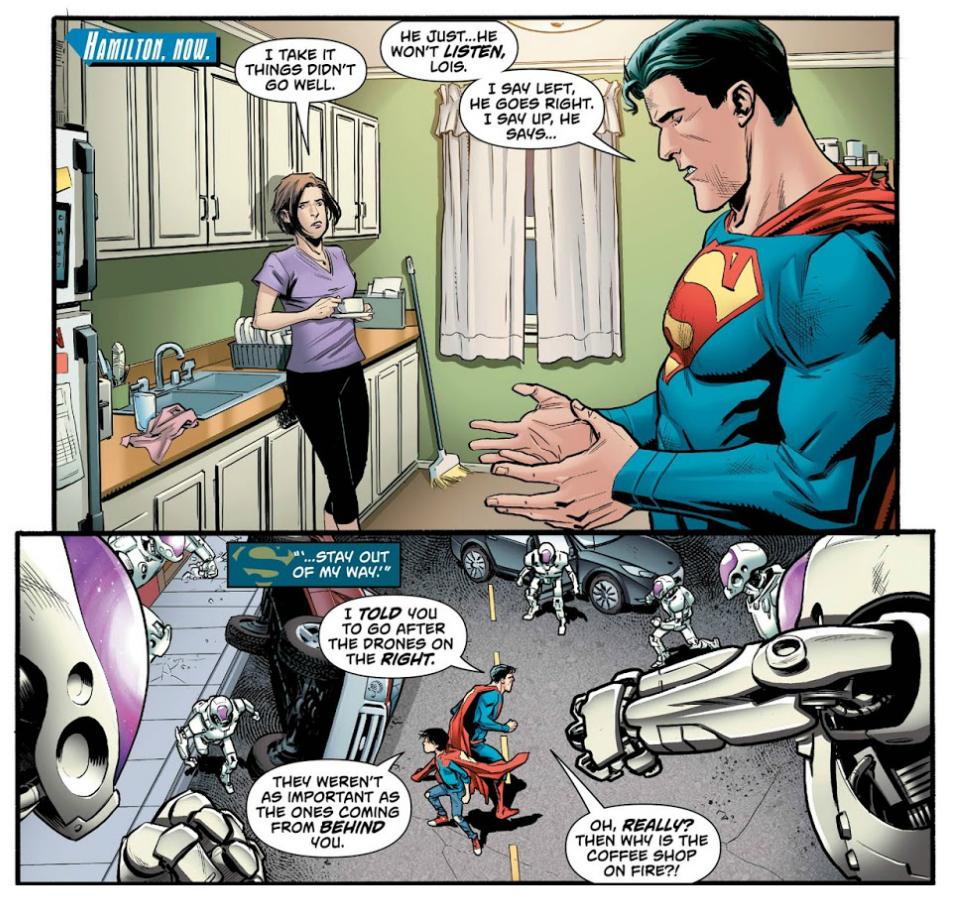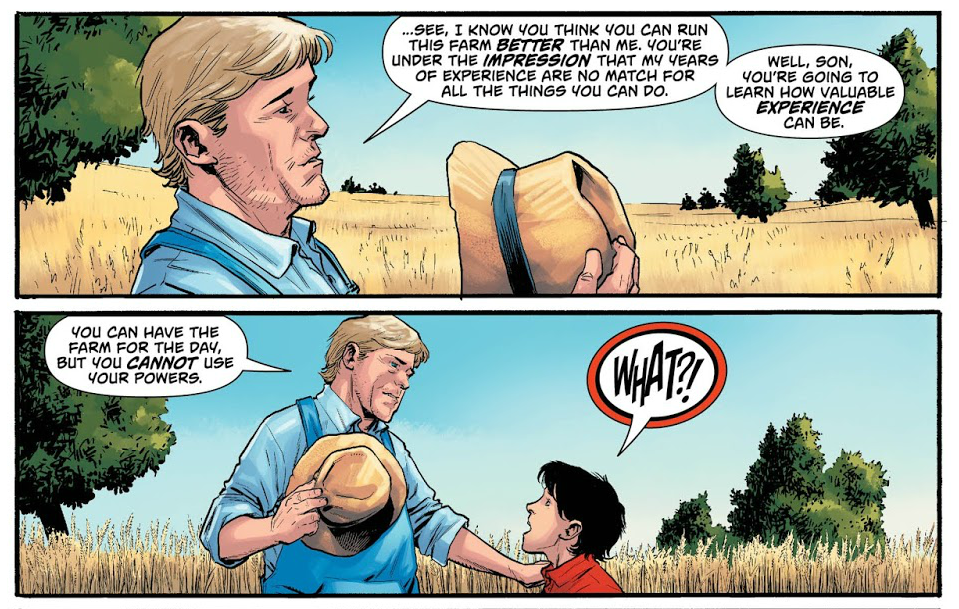By Jarrod Jones. It has been more than a year since DC Comics kicked off its highly successful Rebirth initiative — and with it, an era of optimism, hope, and legacy.
If there’s one character who’s benefited the most from Rebirth it’s certainly Superman. Given the impenetrable quagmire the Man of Steel wound up in thanks to the New 52, the path forward for Superman seemed obvious: reach back. Find the things that defined him for the past seventy-plus years and let them define him once more. Scrap the irony. Further the legend. While Action Comics doubled down on its widescreen spectacle, Superman focused on all the meaty character stuff. The balance has been, to say the least, exquisite.
With the Superman creative team of Peter J. Tomasi, Patrick Gleason, and Doug Mahnke taking a well-deserved break, Michael Moreci and Scott Godlewski have stepped in to provide us with a stand-alone issue that not only builds upon the dichotomy between Clark Kent and his son, Jonathan, it illustrates why this change to the Superman mythos has been so important.
Let’s take a look at Superman #26. Needless to say, spoilers ahead.
Written by Michael Moreci.
Art by Scott Godlewski.
Colors by Hi-Fi.
Letters by Rob Leigh.
New 52 = What Not To Do. It was a frustrating era. In an attempt to make Superman “more relatable”, DC Comics had paradoxically stripped the character of his most relatable elements. Friends, family, an earnest devotion to truth and justice — the entire framework that had made Superman one of the most human characters in pop culture all of a sudden became less important than showing how “now” the initiative had made him.
For a while there you could read the adventures of Superman as he knocked around his fellow members of the Justice League decked out in an armor-plated suit, a brash, youthful disposition, and a shaggy haircut. Later on, he would make out with Wonder Woman. Dark times.
There is no limit to the kind of stories you can tell with Superman. But there are only so many ways to make the reader care about that kind of Superman.
Then Rebirth came along and changed things almost immediately. After the surprisingly affecting “Last Days of Superman”, the refurbished DCU became home to a more recognizable Man of Steel. Thanks to the steady world-building that took place in Dan Jurgens and Lee Weeks’ Superman: Lois & Clark, the Superman that arrived to this initiative was still a husband to Lois Lane, and — in perhaps the most impressive commitment to change I’ve seen from DC Comics in possibly ever — a father to his son, Jonathan Kent. Suddenly, the sky was hardly the limit.
In issue #26, Michael Moreci and Scott Godlewski tackle the relationship between Superman & Son head-on, and it’s an incredible success.
Brains and Brawn. For nearly a decade, Michael Moreci has been plugging away in the industry with an unwavering dedication to quality. That’s not hyperbole; one cursory scan of his bibliography says quite a bit about the writer, from his work at Image Comics (Hack/Slash, Roche Limit) and Heavy Metal (Hoax Hunters) to his time at BOOM! Studios (Burning Fields, with Tim Daniel) and Dynamite (where he contributed one of my favorite Shadow yarns, 2014’s Agents of the Shadow). Moreci’s been great at this job for so long that it was almost funny when his name popped up in DC’s New Talent Showcase earlier this year. (He wrote the A+ standalone short, “White Lantern: Dead Beacons”.)
That career development has brought Moreci to Superman. Teamed with artist Scott Godlewski, Moreci’s first crack at Superman is a wonder of character, talent, and story.
If Godlewski’s continued excellence on Copperhead was already the perfect primer for the inherent sci-fi dazzle of Superman, then his recent history with Vertigo (The Dark and Bloody, The Lost Boys) makes him overqualified. With Superman #26, Godlewski’s recognizably sleek linework lends his compositions a Kryptonian-level heft. Whether Superman and Superboy are pummeling robots in broad daylight or sharing a moment at sunset, Godlewski injects enough heart into his renderings that it’s almost impossible not to stare. Superman has been a great-looking book since Rebirth began. Godlewski makes sure it stays that way.
Those compositions are bolstered with a brimming optimism by Hi-Fi’s reliably detail-oriented hues. We already know Hi-Fi has the goods, so it was no surprise that his work here would be the throughline that made Moreci and Godlewski’s contributions a perfect companion to the works of Gleason, Gray, Mahnke, and Mendoza.
Pa Kents. There’s a moment in this issue that really stands out in my mind. It’s a moment that provides a disarming amount of depth, and it illustrates the themes Moreci aspires to gorgeously.
Towards the middle of an issue that focuses on how Clark Kent is struggling to be as good a role model to his son as his adoptive father was, Superman and Superboy hurtle towards a runaway train. Dad gives son the freedom to rescue the passengers and crew from disaster, and as Superboy assumes the lead his father trails back, a look of measured concern on his face — and a little bit of hope too.
Godlewski composes this sequence with his trademark minimalism. White negative space surrounds these two heroes as Superboy pulls ahead, but our focus remains fixed on the characters in the center thanks to the facial expressions Godlewski provides Superman and Superboy. Even though there are more raucous moments in the issue (like the Super-fellas taking on a small-scale alien invasion) and more touching ones (particularly in the last four pages), this moment turns out to be the most dramatic.
That’s primarily because the sequence drives home the emotional thrust of the story. Throughout the book are flashbacks featuring Clark as a kid and the handful he was to his old man. Moreci juxtaposes Clark’s impetuousness with young Jonathan’s and deftly illustrates how aware Superman is that the apple didn’t fall far from the tree. The moment shows how much of Clark is inside of Jonathan, and how much that actually worries him. This is the superhero equivalent of a father running alongside his kid on a bicycle and then letting the handlebars go. Naturally, I was a mess.
The Future. Superman’s effectiveness as a hero came from his upbringing, which kind of makes Ma and Pa Kent the unsung heroes of the DC Universe. (A fact that is both punctuated by their noted absence since the advent of the New 52 and makes Pa Kent’s appearance in flashback that much more bittersweet.) That’s a sentiment shared succinctly by “Brains vs. Brawn”, only Pa Kent’s first name is now Clark. What that holds in store for Superboy’s future remains to be seen, but one thing’s for certain: there are so many kinds of stories you can tell with that.
Above all, perhaps the most encouraging thing about Superman #26 is that it cements into place the fact that Superman has become the sort of book where even its fill-in issues are something to applaud. Moreci and Godlewski’s efforts aren’t just impressive — they’re a welcome addition to the Superman mythology.
9 out of 10
What did you think about ‘Superman’ #26? Sound off in the comments below.

















